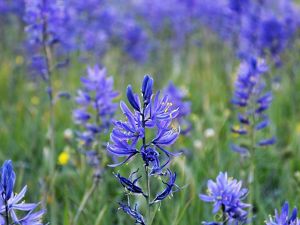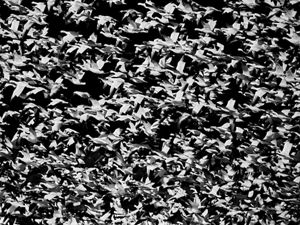Beaver Mimicry Projects Could Be Key to Restoring Wetlands
Dams built to mimic those built by beavers may help stabilize streams.
Left to their own devices, streams are messy. They wander and wind, pushing up against one bank before turning to swirl around another. In the spring, they pour over the top of the walls created to contain them, flooding wetlands and bringing water and life to everything from willows to deer.
Humans have spent more than a century changing those messy creeks and rivers for countless reasons. And in many cases, the end result is a straighter stream cut deep into the ground that flows hard and fast during runoff and slows to a warm trickle or dries completely in the fall.
On a western landscape that grows drier and thirstier by the year, some researchers and land managers are turning to North America’s original dam builders for help: beavers. Once nearly extirpated from the West because of trapping, disease and conflicts, beavers are now being considered part of the solution to not just reestablishing natural rivers, but even as potential tool to combat a changing climate.
Recent research is beginning to show that if humans create dams to mimic those built by beavers, the final result can lure beavers back and ultimately result in the same positive effects for fish, wildlife and vegetation.
“We don’t have a lot of control over weather or climate,” said Rebekah Levine, an assistant professor of environmental sciences at the University of Montana Western who has spent her career studying streams and beavers.
“We know there are a certain number of people down the stream who will be drawing down the water. We know temperatures are warming. We know there is a certain amount of rain and snow that falls during the year. Those are our constraints. So, what are the ways we can push these systems into the positive in terms of water in the fall? We hope beaver dams could be a helpful solution.”
In the past several years, researchers like Levine have worked with officials from Idaho and Montana’s fish and game agencies, Nature Conservancy staff, and others to recreate beaver dams to stabilize streams, create healthier ecosystems and reestablish the native mammals.

The Story of Tygee Creek
On the east side of Henry’s Lake near the Idaho and Montana border, flows a stream called Tygee Creek.
As with many western creeks, years of disease and trapping took their toll on beavers and the complex system of dams, ponds and wetlands the mammals create, said Matthew Ward, manager of TNC’s Flat Ranch Preserve.
One day, local Idaho Department of Fish and Game (IDFG) officers trapped a family of beavers causing issues for landowners in the Henry’s Fork and brought them to Tygee Creek. Despite willows lining the banks, the beavers didn’t stay. Ward and others theorized it was likely because the creek lacked any existing ponds or cover.
“We went in there and built these beaver mimicry projects,” he said. “You pound logs into the stream bed and weave willows into them. It holds back water, but also allows fish passage.”
Within two or three weeks, ponds returned.
The structure was one of many new types researchers are trying—varying in design, stability and materials, Levine said.
Ward hopes the next time wildlife officials encounter problem beavers, they will relocate the animals to the new dams and ponds on Tygee Creek. The project is one of a handful across portions of Idaho and Montana and funded by TNC and its partners where researchers are building structures that mimic what a real beaver might create, solving stream problems and recruiting beavers back into the ecosystems.
The Beauty of a Beaver Dam
Beavers obsessively chew down trees and shrubs to build sprawling, often elaborate dams and lodges in streams and rivers. The result is a complex series of ponds and wetlands that hold water throughout the year.
But unlike traditional human dams, which are much larger and more solid, beaver dams, or structures meant to mimic beaver dams, are constantly evolving. They allow water to flow through, and are natural structures that have evolved with everything in a stream from tiny invertebrates to native trout.
When they break, Levine said, they send willows and cottonwood stems downstream to ultimately sprout and regrow somewhere else, further stabilizing the streambank.
The relatively inexpensive structures not only hold water back, preventing it from all rushing down at one time and covering fish spawning beds with sediment, they create wetlands that merge with cooler groundwater, dropping temperatures downstream, said Damon Keen, IDFG’s regional fisheries biologist for Henry’s Lake.
The effect is crucial for cutthroat trout that spawn in early spring. As the fry emerge in July and August, flow from cool, subsurface water improves survival. Without natural stream function, base flows during these critical months is diminished, streams warm and natural recruitment is poor, Keen said.
Most of the projects in Idaho and Montana are still new, either in their infancy or planning stages, and more monitoring is needed, Levine said.
But early results are promising. Beavers have moved back in some areas. Wetlands are increasing in all of them. And a few upper reaches of western streams are messy again.





